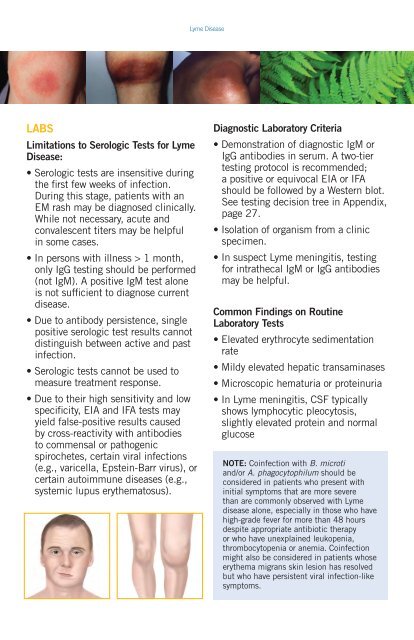tick-borne-dx-physician
tick-borne-dx-physician
tick-borne-dx-physician
You also want an ePaper? Increase the reach of your titles
YUMPU automatically turns print PDFs into web optimized ePapers that Google loves.
Lyme Disease<br />
LABS<br />
Limitations to Serologic Tests for Lyme<br />
Disease:<br />
• Serologic tests are insensitive during<br />
the first few weeks of infection.<br />
During this stage, patients with an<br />
EM rash may be diagnosed clinically.<br />
While not necessary, acute and<br />
convalescent titers may be helpful<br />
in some cases.<br />
• In persons with illness > 1 month,<br />
only IgG testing should be performed<br />
(not IgM). A positive IgM test alone<br />
is not sufficient to diagnose current<br />
disease.<br />
• Due to antibody persistence, single<br />
positive serologic test results cannot<br />
distinguish between active and past<br />
infection.<br />
• Serologic tests cannot be used to<br />
measure treatment response.<br />
• Due to their high sensitivity and low<br />
specificity, EIA and IFA tests may<br />
yield false-positive results caused<br />
by cross-reactivity with antibodies<br />
to commensal or pathogenic<br />
spirochetes, certain viral infections<br />
(e.g., varicella, Epstein-Barr virus), or<br />
certain autoimmune diseases (e.g.,<br />
systemic lupus erythematosus).<br />
Diagnostic Laboratory Criteria<br />
• Demonstration of diagnostic IgM or<br />
IgG antibodies in serum. A two-tier<br />
testing protocol is recommended;<br />
a positive or equivocal EIA or IFA<br />
should be followed by a Western blot.<br />
See testing decision tree in Appendix,<br />
page 27.<br />
• Isolation of organism from a clinic<br />
specimen.<br />
• In suspect Lyme meningitis, testing<br />
for intrathecal IgM or IgG antibodies<br />
may be helpful.<br />
Common Findings on Routine<br />
Laboratory Tests<br />
• Elevated erythrocyte sedimentation<br />
rate<br />
• Mildy elevated hepatic transaminases<br />
• Microscopic hematuria or proteinuria<br />
• In Lyme meningitis, CSF typically<br />
shows lymphocytic pleocytosis,<br />
slightly elevated protein and normal<br />
glucose<br />
NOTE: Coinfection with B. microti<br />
and/or A. phagocytophilum should be<br />
considered in patients who present with<br />
initial symptoms that are more severe<br />
than are commonly observed with Lyme<br />
disease alone, especially in those who have<br />
high-grade fever for more than 48 hours<br />
despite appropriate antibiotic therapy<br />
or who have unexplained leukopenia,<br />
thrombocytopenia or anemia. Coinfection<br />
might also be considered in patients whose<br />
erythema migrans skin lesion has resolved<br />
but who have persistent viral infection-like<br />
symptoms.



